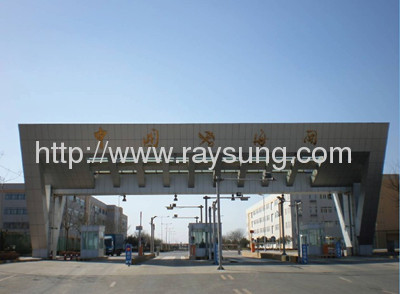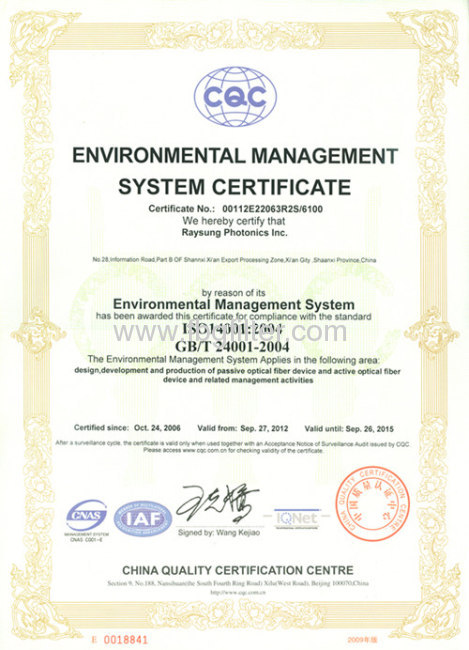
FBG fiber bragg grating
| Min. Order: | 100 Piece/Pieces |
|---|---|
| Payment Terms: | D/A, T/T, WU |
| Supply Ability: | 50000/Month |
| Place of Origin: | Shaanxi |
Company Profile
| Location: | Xi'an, Shaanxi, China (Mainland) |
|---|---|
| Business Type: | Manufacturer, Trading Company |
| Main Products: | Athermal Packaged FBG Filter, Lensed Lens Lenses Fiber, Fiber Bragg Grating (FBG), Narrow Bandwidth Fiber Bragg Grating, Wavelength Locker Fiber Bragg Grating |
Product Detail
| Model No.: | FBG |
|---|---|
| Means of Transport: | Air |
| Brand Name: | Raysung |
| Center Wavelength: | 970~980nm,1060~1066nm,1530~1573nm, custom |
| reflectivity: | 0.5%-99.99% |
| FWHM: | 0.1-1.5nm |
| FBG Type: | Apodized FBG |
| FBG Length: | 0.15mm-15mm |
| SMSR: | >15dB |
| Recoating: | Acrylate |
| Recoating length: | Custom |
| Proof Test: | >150Kpsi |
| Fiber Type: | HI1060,HI980.PM980 |
| Production Capacity: | 50000/Month |
| Packing: | high quality carton |
| Delivery Date: | 4 weeks |
Product Description
The structure of the FBG
The structure of the FBG can vary via the refractive index, or the grating period. The grating period can be uniform or graded, and either localised or distributed in a superstructure. The refractive index has two primary characteristics, the refractive index profile, and the offset. Typically, the refractive index profile can be uniform or apodized, and the refractive index offset is positive or zero.
There are six common structures for FBGs;[14]
uniform positive-only index change,
Gaussian apodized,
raised-cosine apodized,
chirped,
discrete phase shift, and
superstructure.
The first complex grating was made by J. Canning in 1994.[15][citation needed] This supported the development of the first distributed feedback (DFB) fiber lasers, and also laid the groundwork for most complex gratings that followed, including the sampled gratings first made by Peter Hill and colleagues in Australia.[citation needed]
Apodized gratings
There are basically two quantities that control the properties of the FBG. These are the grating length, , given as
and the grating strength, . There are, however, three properties that need to be controlled in a FBG. These are the reflectivity, the bandwidth, and the side-lobe strength. As shown above, in the strong grating limit (i.e., for large ) the bandwidth depends on the grating strength, and not the grating length. This means the grating strength can be used to set the bandwidth. The grating length, effectively , can then be used to set the peak reflectivity, which depends on both the grating strength and the grating length. The result of this is that the side-lobe strength cannot be controlled, and this simple optimisation results in significant side-lobes. A third quantity can be varied to help with side-lobe suppression. This is apodization of the refractive index change. The term apodization refers to the grading of the refractive index to approach zero at the end of the grating. Apodized gratings offer significant improvement in side-lobe suppression while maintaining reflectivity and a narrow bandwidth. The two functions typically used to apodize a FBG are Gaussian and raised-cosine.
Chirped fiber Bragg gratings
The refractive index profile of the grating may be modified to add other features, such as a linear variation in the grating period, called a chirp. The reflected wavelength changes with the grating period, broadening the reflected spectrum. A grating possessing a chirp has the property of adding dispersion—namely, different wavelengths reflected from the grating will be subject to different delays. This property has been used in the development of phased-array antenna systems and polarization mode dispersion compensation, as well.
Tilted fiber Bragg gratings
In standard FBGs, the grading or variation of the refractive index is along the length of the fiber (the optical axis), and is typically uniform across the width of the fiber. In a tilted FBG (TFBG), the variation of the refractive index is at an angle to the optical axis. The angle of tilt in a TFBG has an effect on the reflected wavelength, and bandwidth.
Long-period gratings
Typically the grating period is the same size as the Bragg wavelength, as shown above. For a grating that reflects at 1,500 nm, the grating period is 500 nm, using a refractive index of 1.5. Longer periods can be used to achieve much broader responses than are possible with a standard FBG. These gratings are called long-period fiber grating. They typically have grating periods on the order of 100 micrometers, to a millimeter, and are therefore much easier to manufacture.
About Raysung Photonics Inc:
Raysung photonics located in the export processing zone of Xi'an, China, is specialized in manufacturing FBG, lensed fiber and FBG filter for FTTH. Besides those three main products, Raysung can also manufacture wavelength stabilizer, DWDM FBG filter, chirped fiber grating, long period grating, custom fiber grating and so on. In addition, Raysung has ability to develop and produce special gratings for sensor. The company is committed to the research, design and producing of those products and it is the only one manufacture which has the capacity to volume- producing all sorts of fiber grating in China. Moreover, Raysung is one of the only manufactures in the world who has the capacity to manufacture the type of optical fiber which incorporates FBG and lensed fiber. Raysung's products are widely used in aerospace, construction industry, coal industry etc. The company's professional teams have rich experience in photoelectric area and we have advanced technology and equipment. This allows us to provide our customers with high-quality products and optimized proposals.



In 2006, Raysung completed ISO9001: 2000 and ISO14001 certification and also obtained several patent rights. The materials of our products accord with RoHS criterion. Raysung's products are always superior in quality and competitive in price.







.gif)
